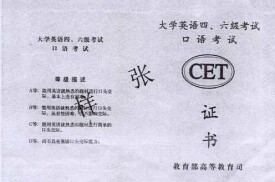英語四六級口語考試
英語四六級口語考試
大學英語四、六級考試口語考試(CET Spoken English Test,簡稱CET-SET),是用於測量我國大學生運用英語進行口頭交際的能力的英語考試。
一年兩次,分別在5月和11月。成績查詢時間,分別為每年的八月和二月的中下旬,與筆試成績一同公布。
2017年開始報考資格為:
考試分為全國大學英語四級口語考試(CET-SET4),全國大學英語六級口語考試(CET-SET6)。
四級口語考試:完成當次四級筆試報考後方可報考四級口試,例如完成2017年6月CET4報考後可報考2017年5月CET-SET4。
六級口語考試:完成當次六級筆試報考後方可報考六級口試,例如完成2017年6月CET6報考後可報考2017年5月CET-SET6。
口試不需要筆試過一定分數線才能報考,口試筆試分開考。
一年兩次,分別在5月和11月。
成績查詢時間,分別為每年的八月和二月的中下旬,與筆試成績一同公布。
2016年5月全國大學英語四、六級口語考試將於5月20-21日舉行。其中5月20日:全國大學英語四級口語考試(CET-SET4),5月21日:全國大學英語六級口語考試(CET-SET6)。
2020年4月16日,為落實國家關於新冠肺炎疫情防控工作部署及教育部相關通知要求,切實保障考生、考試工作人員的身體健康和生命安全,經教育部考試中心研究決定,取消原定於2020年5月23至24日的全國大學英語四六級口語考試(CET-SET)。筆試待定。
CET-SET考試採用機考形式,每場考試由2名主考和3(或4)名考生組成:
CET-SET考試分三部分:
第一部分是考生和CET授權的主考進行交談,採用問答的形式。時間約5分鐘。
第二部分包括1.5分鐘的考生個人發言和4.5分鐘的小組討論。時間共約10分鐘。
第三部分由主考再次提問以進一步確定考生的口頭交際能力。時間約5分鐘。
由於改革,有些省份實施機考形式。兩個考生為一組參加。
第一部分為簡單的自我介紹和問題回答,其中自我介紹20秒,問題回答為90秒。
第二部分為topic,及與你的partner進行有關此給出話題的討論,時間為4分30秒。
第三部分為總結式回答,包括兩個問題,其中一個與你的partner相同,另一個不同。時間均為90秒。
Part 1
5 分鐘
問答
“熱身”題,包括考生自我介紹、回答問題。
Part 2
10 分鐘
發言 和 討論
考生準備 1 分鐘后,根據所給提示作一個 1.5 分鐘的發言;小組就指定的話題討論(約 4.5 分鐘)。
Part 3
5 分鐘
問答
由主考進一步提問。
考試總分為 15 分,分為 A 、 B 、 C 和 D 四個等級。C 等以上者將獲得由教育部高教司頒發的注有 CET Spoken English Test 成績等級的CET證書
A+ 14.5-15分
A 13.5-14.4分
能用英語就熟悉的題材進行口頭交際,基本上沒有困難。
B+ 12.5-13.4 分
B 11-12.4 分
能用英語就熟悉的題材進行口頭交際,雖有些困難,但不影響交際。
C+ 9.5-10.9 分
C 8-9.4 分
能用英語就熟悉的題材進行簡單的口頭交際。
D7.9 分以下
尚不具有英語口頭交際能力。
5 分
· 語法和辭彙基本正確
· 表達過程中辭彙豐富、語法結構較為複雜
· 發音較好,但允許有一些不影響理解的母語口音
· 在討論有關話題時能進行較長時間的、語言連貫的發言,但允許由於無法找到合適的詞語而造成的偶爾停頓
· 能夠自然、積極地參與討論
· 語言的使用總體上能與語境、功能和目的相適應
4 分
· 語法和辭彙有一些錯誤,但未嚴重影響交際
· 表達過程中辭彙較豐富
· 發音尚可
· 能進行較連貫的發言,但多數發言較簡短
· 組織思想和搜尋詞語時頻繁出現停頓,有時會影響交際
· 能夠較積極地參與討論,但有時內容不切題或未能與小組成員直接交流
· 語言的使用基本上能與語境、功能和目的相適應
3 分
· 語法和辭彙有錯誤,且有時會影響交際
· 表達過程中辭彙不豐富,語法結構較簡單
· 發音有缺陷,有時會影響交際
· 發言簡短
· 組織思想和搜尋詞語時頻繁出現較長時間的停頓,影響交際,但能夠基本完成交際任務
· 不能積極參與討論,有時無法適應新話題或討論內容的改變
2 分
· 語法和辭彙有較多錯誤,以致妨礙理解
· 表達過程中因缺乏辭彙和語法結構而影響交際
· 發音較差,以致交際時常中斷
· 發言簡短且毫無連貫性,幾乎無法進行交際
· 不能參與小組討論
大學英語四、六級考試口語考試樣題
CET Spoken English Test
Sample Paper
Topic A - 1
Topic Area : City Life
Topic : City Traffic
Part 1 (5 minutes)
Examiner:
Good morning (Good afternoon), everybody. Could you please tell me your name and the number of your admission ticket? Your name, please. And your number? … Your name? … And your number? ... Thank you.
Now would you please briefly introduce yourselves to each other? Remember, you should not mention the name of your university. (1.5 minutes)
OK, now that we know each other we can do some group work. First of all, I'd like to ask each of you to say something about life in the city.
[ C1, C2, C3 ]
1) How do you like living in Beijing ( Shanghai , Nanjing …)?
2) What do you think is the most serious challenge of living in a city like Beijing ( Shanghai , Nanjing …)?
3) How do you like shopping in a supermarket?
4) Where would you like to live, downtown or in the suburbs, and why?
5) What measures do you think we should take to reduce air pollution in Beijing ( Shanghai , Nanjing …)?
6) Can you say something about the entertainment available in your city?
7) Where would you like to find a job after graduation, in a big city like Beijing or Shanghai or in a small town and why?
8) What's your impression of the people in Beijing ( Shanghai , Nanjing …)?
Part 2 (10 minutes)
Examiner:
Now let's move on to something more specific. The topic for our discussion today is “City Traffic”. You'll have a picture (some pictures) showing two different types of transport. I'd like each of you to give a brief description of each type and then compare the two types. You'll have one minute to prepare and each of you will have one and a half minutes to talk about the picture(s). Don't worry if I interrupt you at the end of the time limit. Now here are your pictures.
[1 minute later]
Now, [ C1 ], would you please start first? [ C2 ] and [ C3 ], please put your pictures aside and listen to what [ C1 ] has to say.
[1.5 minutes later] OK. [ C2 ], now it's your turn.
[1.5 minutes later] OK, [ C3 ], and now it's your turn.
Right. Now we all have some idea of various kinds of city transport. I'd like you to discuss this topic further and see if you can agree on which is the best type of transport for a big city like Beijing ( Shanghai , Nanjing …). During the discussion you may argue with each other or ask each other questions to clarify a point. You will have about four and a half minutes for the discussion. Your performance will be judged according to your contributions to the discussion.
[If one candidate talks too long]
Sorry, I'll have to stop you now. Let's listen to what [ C? ] has to say.
[If one candidate keeps silent for a long time] /
Now, [ C? ], could you please say something about your view of …?
[4.5 minutes later]
All right, that's the end of the discussion.
Part 3 (5 minutes)
Examiner:
Now I'd like to ask you just one last question on the topic of “City Traffic”.
[Select a question from the following list to ask each of the candidates.]
[ C1 or C2 or C3 ]
· During the discussion, why did you say that ... ?
· What kind of transport do you usually use in your city?
· Do you have any suggestions as to how traffic conditions can be improved in big cities?
· Do you think private cars should be encouraged?
· Why do you think some Western countries encourage people to ride bicycles?
Now, that's the end of the test. Thank you, everybody.
體例說明:
內容
體例
舉例
· 主考用語 :
黑體
Good morning.
· 對主考的提示 :
[ 白體 ]
[Interrupt him/her if …]
· 變數(考生姓名) :
[ 斜體 ]
[ C1 ]
· 時間提示 :
( 白體 )
(5 minutes)
· 過程說明 :
斜體
Part 1
· 可變換的內容 :
( )
Good morning (Good afternoon)
